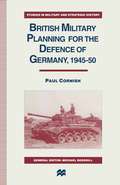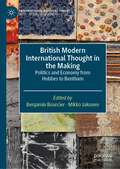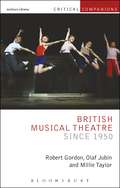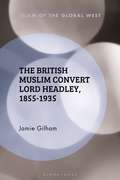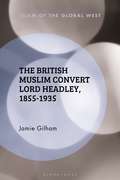- Table View
- List View
British Microcars 1947–2002 (Shire Library #849)
by Duncan CameronFrom the 1940s to the 1960s, the microcar posed a challenge to the large companies that mass-produced cars to uniform designs. The microcar was the opposite, produced by small entrepreneurial start-ups using quirkydesign concepts that offered motorists cheaper and more economical vehicles. This book is a beautifully illustrated history of the British microcar, from the early days of Bond and Reliant to the proliferation of micro marques during the 1950s and their demise during the 1960s. It explores many eccentric British concepts, comparing the cars to their influential European competitors, examining the social and economic reasons for the decline and disappearance of the microcar, but also saluting the signs of a microcar renaissance in the twenty-first century, this time from mainstream manufacturers.
British Military History For Dummies
by Bryan PerrettA plain-English guide to Britons in battle, from the Roman invasion to the ongoing Iraqi war Charging through the Britain's military past, this accessible guide brings to life the battles and wars that shaped the history of Britain-and the world. The book profiles commanders, explains strategies and tactics, and covers key developments in weaponry and technology.
British Military Intelligence in the Crimean War, 1854-1856 (Studies in Intelligence)
by Stephen M. HarrisThis is a study of the British military intelligence operations during the Crimean War. It details the beginnings of the intelligence operations as a result of the British Commander, Lord Raglan's, need for information on the enemy, and traces the subsequent development of the system.
British Military Intelligence in the Crimean War, 1854-1856 (Studies in Intelligence)
by Stephen M. HarrisThis is a study of the British military intelligence operations during the Crimean War. It details the beginnings of the intelligence operations as a result of the British Commander, Lord Raglan's, need for information on the enemy, and traces the subsequent development of the system.
British Military Planning for the Defence of Germany 1945–50 (Studies in Military and Strategic History)
by Paul CornishUsing recently released archive material, British Military Planning for the Defence of Germany, 1945-50, reassesses Britain's strategy for the defence of Germany up to the outbreak of the Korean War. Convinced of the capabilities of strategic air power with atomic weapons, and convinced that the defence of the Middle East should be the first call on British planning, Britain's military chiefs made a series of token gestures designed to boost French morale and consistently refused to make a genuine 'continental commitment' of operational troops.
British Military Withdrawal and the Rise of Regional Cooperation in South-East Asia, 1964-73
by S. ThompsonThis book examines the links between Britain's withdrawal from its east of Suez role and the establishment of South-East Asian regional security arrangements. The link between these two events is not direct, but a relationship existed, which is important to a wider understanding of the development of regional security arrangements.
The British Miner in the Age of De-Industrialization: A Political and Cultural History
by Jörg ArnoldThe British coal industry no longer exists and yet the figure of the coal miner lives on in the British cultural imagination. In feature films and documentaries, miners are typically portrayed as proletarian traditionalists working in a dying industry. Taking this perspective, the 1984/85 miners' strike seems a desperate last stand against forces much bigger than the miners themselves — not just the Thatcher government but the tide of historical change itself. In this ground-breaking study, Jörg Arnold challenges a declinist reading of the people working in one of Britain's most important energy industries. The study makes extensive use of previously inaccessible records to offer a new account of the British miner in the age of de-industrialisation. The book situates the miners in broader structures of feeling, and reconstructs the miners' sense of the past and the future. Arnold argues that Britain's miners went through a cyclical movement — from loser to winner and back again — as Britain underwent a de-industrial revolution in the final decades of the twentieth century. The book reinserts the industry's 'new dawn' of the 1970s into the story of coal and shows that the miners wielded real power. The industry's reversal of fortunes, inscribed in Plan for Coal (1974), proved short-lived. It was significant all the same. Its significance, the book argues, did not lie in affecting the long-term trajectory of the coal industry. Rather, the 'new dawn' was important in raising the political and cultural stakes. The miners found themselves at the centre of sharply conflicting visions of the future at a critical juncture in Britain's history. The figure of the coal miner became invested with sharply contrasting characteristics: hero and villain, underdog and enemy, proletarian traditionalist and standard bearer of Socialist advance. The miners were no mere spectators in this process. They were agents, thought to be uniquely powerful by their numerous opponents, and half believing in this power themselves. The miners' special nature, however, jarred with the aspiration to lead an ordinary life, producing tensions that were most cruelly exposed in the year-long strike of 1984/1985.
The British Miner in the Age of De-Industrialization: A Political and Cultural History
by Jörg ArnoldThe British coal industry no longer exists and yet the figure of the coal miner lives on in the British cultural imagination. In feature films and documentaries, miners are typically portrayed as proletarian traditionalists working in a dying industry. Taking this perspective, the 1984/85 miners' strike seems a desperate last stand against forces much bigger than the miners themselves — not just the Thatcher government but the tide of historical change itself. In this ground-breaking study, Jörg Arnold challenges a declinist reading of the people working in one of Britain's most important energy industries. The study makes extensive use of previously inaccessible records to offer a new account of the British miner in the age of de-industrialisation. The book situates the miners in broader structures of feeling, and reconstructs the miners' sense of the past and the future. Arnold argues that Britain's miners went through a cyclical movement — from loser to winner and back again — as Britain underwent a de-industrial revolution in the final decades of the twentieth century. The book reinserts the industry's 'new dawn' of the 1970s into the story of coal and shows that the miners wielded real power. The industry's reversal of fortunes, inscribed in Plan for Coal (1974), proved short-lived. It was significant all the same. Its significance, the book argues, did not lie in affecting the long-term trajectory of the coal industry. Rather, the 'new dawn' was important in raising the political and cultural stakes. The miners found themselves at the centre of sharply conflicting visions of the future at a critical juncture in Britain's history. The figure of the coal miner became invested with sharply contrasting characteristics: hero and villain, underdog and enemy, proletarian traditionalist and standard bearer of Socialist advance. The miners were no mere spectators in this process. They were agents, thought to be uniquely powerful by their numerous opponents, and half believing in this power themselves. The miners' special nature, however, jarred with the aspiration to lead an ordinary life, producing tensions that were most cruelly exposed in the year-long strike of 1984/1985.
British Miscalculations: The Rise of Muslim Nationalism, 1918-1925
by Isaiah FriedmanIn the aftermath of World War I there was furious agitation throughout Islam against the dismemberment of the Ottoman Empire. Coupled with the powerful effect of the principle of self-determination, British indifference to Muslim sentiments gave rise to militant nationalism in Islam-which became de facto anti-Western. This detailed and convincing account describes British indecisiveness, policy contradictions, and how militant nationalism was aggravated by the Greek invasion of Smyrna and its ambition to create a Hellenic Empire in Anatolia with Britain's connivance. Immediately after World War I there was a fair chance of mutual coexistence and good relations between Arabs and Jews in Palestine. This possibility was nipped in the bud by the military administration (1918-1920) responsible for the anti-Jewish riots in Jerusalem in April 1920. High Commissioner Herbert Samuel supported the Arab extremists in his misguided policy, and complicated the situation further. The appointment of Hajj Amin al-Husseini to the exalted post of Grand Mufti of Jerusalem, and subsequently to the presidency of the Supreme Moslem Council of the Palestinians, proved fatal to Arab-Jewish relations and to the possibility of peace. As Friedman shows, the British administration of Palestine bears a considerable share of responsibility for the Arab-Zionist conflict in Palestine. Against this diplomatic background Arab-Jewish hostilities thrived, with consequences that endure today.
British Miscalculations: The Rise of Muslim Nationalism, 1918-1925
by Isaiah FriedmanIn the aftermath of World War I there was furious agitation throughout Islam against the dismemberment of the Ottoman Empire. Coupled with the powerful effect of the principle of self-determination, British indifference to Muslim sentiments gave rise to militant nationalism in Islam-which became de facto anti-Western. This detailed and convincing account describes British indecisiveness, policy contradictions, and how militant nationalism was aggravated by the Greek invasion of Smyrna and its ambition to create a Hellenic Empire in Anatolia with Britain's connivance. Immediately after World War I there was a fair chance of mutual coexistence and good relations between Arabs and Jews in Palestine. This possibility was nipped in the bud by the military administration (1918-1920) responsible for the anti-Jewish riots in Jerusalem in April 1920. High Commissioner Herbert Samuel supported the Arab extremists in his misguided policy, and complicated the situation further. The appointment of Hajj Amin al-Husseini to the exalted post of Grand Mufti of Jerusalem, and subsequently to the presidency of the Supreme Moslem Council of the Palestinians, proved fatal to Arab-Jewish relations and to the possibility of peace. As Friedman shows, the British administration of Palestine bears a considerable share of responsibility for the Arab-Zionist conflict in Palestine. Against this diplomatic background Arab-Jewish hostilities thrived, with consequences that endure today.
British Mission to the Jews in Nineteenth-century Palestine
by Yaron Perry Elizabeth YodimYaron Perry's account reveals, without bias or partiality, the story of the "London Society for Promoting Christianity Amongst the Jews" and its unique contribution to the restoration of the Holy Land. This Protestant organization were the first to take root in the Holy Land from 1820 onwards.
British Mission to the Jews in Nineteenth-century Palestine
by Yaron Perry Elizabeth YodimYaron Perry's account reveals, without bias or partiality, the story of the "London Society for Promoting Christianity Amongst the Jews" and its unique contribution to the restoration of the Holy Land. This Protestant organization were the first to take root in the Holy Land from 1820 onwards.
British Modern International Thought in the Making: Politics and Economy from Hobbes to Bentham (International Political Theory)
by Benjamin Bourcier Mikko JakonenThis book articulates international political theory in dialogue with economics on several questions. It asks: how has modern international theory been adjusted and nourished by economic ideas, theories and practices? How far has the distinctive contribution of some theorists to international theory been informed by their views on economy? What has been the impact of the theory of the state for economic and international theory? What sort of economic thinking has led to revise the debates constitutive for the modern international realm? How have economic debates been rhetorically connected to political debates in the field of international relations?
The British Monarchy For Dummies
by Philip WilkinsonIncludes insights into the lives of the current royal family Britain's heritage told through the colourful lives of its kings and queens The monarchy is at the heart of British life. If you're going to understand Britain and its history, you need to understand the story of its royal family. This lively guide walks you through the history of the British monarchy from the earliest times to the present day and covers the colourful characters, extraordinary events, power struggles, and politics that have shaped one of the most famous institutions in the world. Discover The origins of the British monarchy How the monarchy works The relationship between the royal family and the general public How the role of the monarch has changed over time What the monarch and the rest of the royal family do all day
British Motor Gun Boat 1939–45 (New Vanguard #166)
by Tony Bryan Angus KonstamMotor Gun Boats were the "Spitfires of the Seas†? of the Royal Navy. Bristling with small-calibre guns and machine guns, they served in a variety of roles during the War. In the early war period they battled against German E-boats in the English Channel, then went on the offensive, searching the enemy shore for targets of opportunity. At other times, they ran support for Motor Torpedo Boats and were used to deliver commandos on various raids. Naval Warfare expert, Angus Konstam, tells the story of these small, but destructive boats, beginning with their design and development and carrying through to their operational use in both the European and Mediterranean theatres of World War II.
British Motor Gun Boat 1939–45 (New Vanguard #166)
by Tony Bryan Angus KonstamMotor Gun Boats were the "Spitfires of the Seas†? of the Royal Navy. Bristling with small-calibre guns and machine guns, they served in a variety of roles during the War. In the early war period they battled against German E-boats in the English Channel, then went on the offensive, searching the enemy shore for targets of opportunity. At other times, they ran support for Motor Torpedo Boats and were used to deliver commandos on various raids. Naval Warfare expert, Angus Konstam, tells the story of these small, but destructive boats, beginning with their design and development and carrying through to their operational use in both the European and Mediterranean theatres of World War II.
British Motorcycles of the 1960s and ’70s (Shire Library #654)
by Mick WalkerFor the first half of the 20th century Great Britain led the world in motorcycle design and production, exporting its products to countries in every section of the globe. However, as the second half of the century began in 1960 this once great industry commenced what was to be a terminal decline. During the 1960s and '70s Britain still manufactured a wide range of machines, but a combination of poor management, lack of investment, foreign competition (notably from Japan), and the arrival of the small, affordable car transpired to effectively sound the death knell of the British motorcycle by the end of the 1970s.
British Motorcycles of the 1960s and ’70s (Shire Library)
by Mick WalkerFor the first half of the 20th century Great Britain led the world in motorcycle design and production, exporting its products to countries in every section of the globe. However, as the second half of the century began in 1960 this once great industry commenced what was to be a terminal decline. During the 1960s and '70s Britain still manufactured a wide range of machines, but a combination of poor management, lack of investment, foreign competition (notably from Japan), and the arrival of the small, affordable car transpired to effectively sound the death knell of the British motorcycle by the end of the 1970s.
British Murder Mysteries, 1880-1965: Facts and Fictions (Crime Files)
by Laura E. Nym Mayhall Elizabeth PrevostBritish Murder Mysteries, 1880-1965: Facts and Fictions conceptualizes detective fiction as an archive, i.e., a trove of documents and sources to be used for historical interpretation. By framing the genre as a shifting set of values, definitions, and practices, the book historicizes the contested meanings of analytical categories like class, race, gender, nation, and empire that have been applied to the forms and functions of detection. Three organizing themes structure this investigation: fictive facticity, genre fluidity, and conservative modernity. This volume thus shows how British detective fiction from the late-nineteenth to the mid-twentieth century both shaped and was shaped by its social, cultural, and political contexts and the lived experience of its authors and readers at critical moments in time.
The British Museum (The Landmark Library #7)
by James HamiltonA concise history of one of the world's greatest and most comprehensive museum collections, from its founding in 1753.A product and symbol of the 18th-century Enlightenment, the British Museum is as iconic an expression of that cultural tendency as Johnson's Dictionary, the French Encyclopedie and Linnaean plant classification. Its collections embody the raw material of empiricism – the bringing together of things to enable the widest intellectual experiment to take place. James Hamilton explores the establishment of the Museum in the 1750s (from the bequest to the nation of the collections of Sir Hans Sloane); the chosen site of its location; the cultural context in which it came into being; the subsequent development, expansion and diversification of the Museum, both as a collection and as a building, from the early 19th to the 21st century; the controversy occasioned by some of its acquisitions; and the legacy and influence of the Museum nationally and globally.
British Musical Theatre since 1950 (Critical Companions)
by Robert Gordon Olaf Jubin Millie TaylorThis critical introduction to British musical theatre since 1950 is the first book to discuss its post-war developments from the perspective of British – as opposed to American – popular culture. The genre is situated within the historical context of post-war British society in order to explore the range of forms through which significant sociocultural moments are represented. Introductory chapters analyse the way British musicals have responded to social change, the forms of popular theatre and music from which they have developed and their originality in elaborating new narrative strategies since the seventies. A key feature of the book is its close readings of twelve key works, from Salad Days (1954) and Oliver! (1960) to global smash hits such as Les Misérables (1985) and The Phantom of the Opera (1986) and beyond, including the latest critical and box-office success Matilda (2011). Also analysed are British favourites (Blood Brothers, 1983), cult shows (The Rocky Horror Show, 1975) and musicals with a pre-existing fan-base, such as Mamma Mia! (1999).
British Musical Theatre since 1950 (Critical Companions)
by Robert Gordon Olaf Jubin Millie TaylorThis critical introduction to British musical theatre since 1950 is the first book to discuss its post-war developments from the perspective of British – as opposed to American – popular culture. The genre is situated within the historical context of post-war British society in order to explore the range of forms through which significant sociocultural moments are represented. Introductory chapters analyse the way British musicals have responded to social change, the forms of popular theatre and music from which they have developed and their originality in elaborating new narrative strategies since the seventies. A key feature of the book is its close readings of twelve key works, from Salad Days (1954) and Oliver! (1960) to global smash hits such as Les Misérables (1985) and The Phantom of the Opera (1986) and beyond, including the latest critical and box-office success Matilda (2011). Also analysed are British favourites (Blood Brothers, 1983), cult shows (The Rocky Horror Show, 1975) and musicals with a pre-existing fan-base, such as Mamma Mia! (1999).
The British Muslim Convert Lord Headley, 1855-1935 (Islam of the Global West)
by Jamie GilhamThis is the first biography of Lord Headley, who made international headlines in 1913 when he defied convention by publicly converting to Islam. Drawing on previously unpublished archival sources, this book focuses on Headley's religious beliefs, conversion to Islam, and work as a Muslim leader during and after the First World War.Lord Headley slipped into obscurity following his death in 1935, but there is growing recognition globally that he is a pivotal figure in the history of Western Islam and Muslim-Christian relations; this book evaluates the strengths and weaknesses, successes and failures of the man and his work, and considers his significance for contemporary understandings of Islam in the Global West.
The British Muslim Convert Lord Headley, 1855-1935 (Islam of the Global West)
by Jamie GilhamThis is the first biography of Lord Headley, who made international headlines in 1913 when he defied convention by publicly converting to Islam. Drawing on previously unpublished archival sources, this book focuses on Headley's religious beliefs, conversion to Islam, and work as a Muslim leader during and after the First World War.Lord Headley slipped into obscurity following his death in 1935, but there is growing recognition globally that he is a pivotal figure in the history of Western Islam and Muslim-Christian relations; this book evaluates the strengths and weaknesses, successes and failures of the man and his work, and considers his significance for contemporary understandings of Islam in the Global West.
British Muslims: New Directions in Islamic Thought, Creativity and Activism
by Philip Lewis Sadek HamidAn innovative study of Brown as a Scottish Catholic writer with a truly international reach



